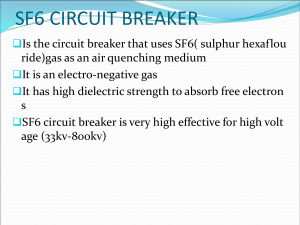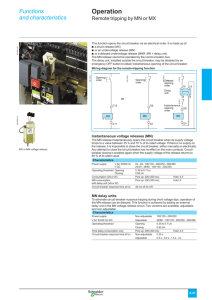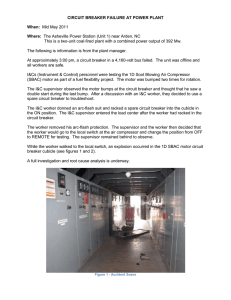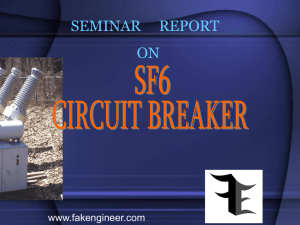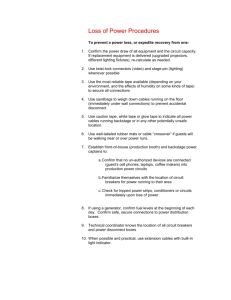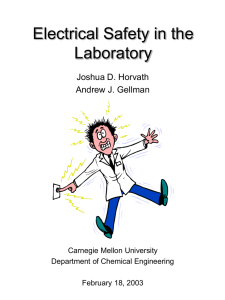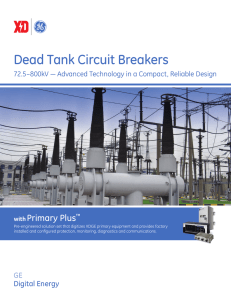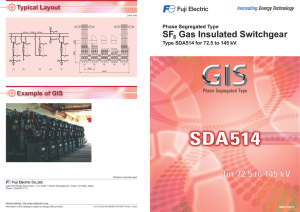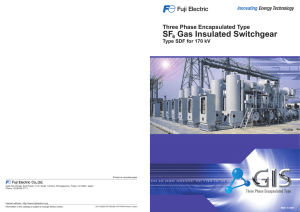FUNDAMENTAL TRAINING ON CIRCUIT BREAKER
advertisement
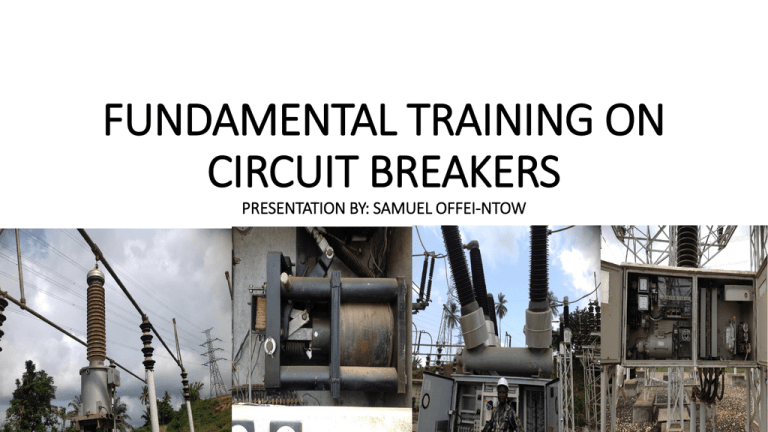
FUNDAMENTAL TRAINING ON CIRCUIT BREAKERS PRESENTATION BY: SAMUEL OFFEI-NTOW WHAT IS A CIRCUIT BREAKER It is a mechanical device used for making and breaking an electric circuit, both manually and automatically in the event of electric faults. This definition is basically for domestic application, i.e. Miniature Circuit Breaker (Low Voltage) However, in the situation of Medium/High Voltages, there are additional devices which makes a breaker function perfectly. SEQUENCE OF OPERATION OF A CIRCUIT BREAKER (CB) Sensing device Commanding device Actuating device EXAMPLES OF EACH OF THE FOLLOWING SEQUENCE OF OPERATION SENSING • Current transformer (CT) COMMANDING Overcurrent relay • Potential transformer (PT) Over Voltage relay • Thermal device (thermocouple) Temperature relay • Gas relays (Buchholz) Gas relay-86G cont. EXAMPLES OF EACH OF THE FOLLOWING SEQUENCE OF OPERATION ACTUATING DEVICE • Circuit Breaker PHOTOS OF SEQUENCE OF OPERATION • SENSING DEVICE • CURRENT TRANSFORMER (CT) THERMOCOUPLE Cont. PHOTOS OF SEQUENCE OF OPERATION COMMANDING DEVICE OVER VOLTAGE OVER TEMPERATURE Cont. PHOTOS OF SEQUENCE OF OPERATION ACTUATING DEVICE Circuit Breaker (CB) DEAD TANK Cont. PHOTOS OF SEQUENCE OF OPERATION ACTUATING DEVICE Circuit Breaker (CB) LIVE TANK TYPES OF CIRCUIT BREAKER The type of a circuit breaker is derived from it’s quenching medium QUENCHING MEDIUM • Oil • Vacuum • SF6 Gas BREAKER TYPE OIL CIRCUIT BREAKER (OCB) VACCUM BREAKER SF6 Vacuum Circuit Breakers INTERRUPTING CHAMBER • This is the name given to the chamber housing the contacts. There are two types of Interrupters (CB) • Live tank • Dead tank • The live tank is where the breaking and making action takes place in an insulated housing. • Similarly, the dead tank is also housed in a metallic envelope. PICTURES OF THE TANKS LIVE TANK DEAD TANK OPERATING MEDIUM • These are the main operating medium used in Medium and High Voltage Network. ELECTROMAGNETIC SPRING FKF SPRING MECHANISM FOR AREVA DEAD TANK SF6 CIRCUIT BREAKERS FKF Mechanism Maintenance Models cont. OPERATING MEDIUM PNEUMATIC HYDRAULIC PROPERTIES OF SULFUR HEXAFLUORIDE (SF6) GAS • Heavy, chemically inert, non toxic • No poisonous effect on the human body but decomposition products are poisonous • Colorless and odorless • It is gaseous at normal room temperature and pressure • Density is about 6.6g/l at 20 degrees Celsius (5 times denser than air) • Critical temperature is at 45.6 degrees Celsius and can be liquefied by compression • Very good insulant with high dielectric strength Cont. PROPERTIES OF SULFUR HEXAFLUORIDE (SF6) GAS • SF6 gas is electo-negative (tends to attract the free electrons and has the arc quenching property). Because of this main reason SF6 gas is used for arc quenching and insulation medium in Circuit Breakers. • The gas is highly stable • Unlike solid insulation materials, electrical breakdown of SF6 gas does not result in permanent deterioration of its properties • Decomposition occurs on the exposure to the electric arc. (Dissociation products will be SF2 and SF4 order fluorides) MAJOR PROPERTIES AT A GLANCE • Colorless and odorless • Five times heavier than air • Temperature-resistant up to 500 degrees Celsius • Chemically stable • Non-toxic • Non-inflammable • Excellent dielectric properties THANK YOU

